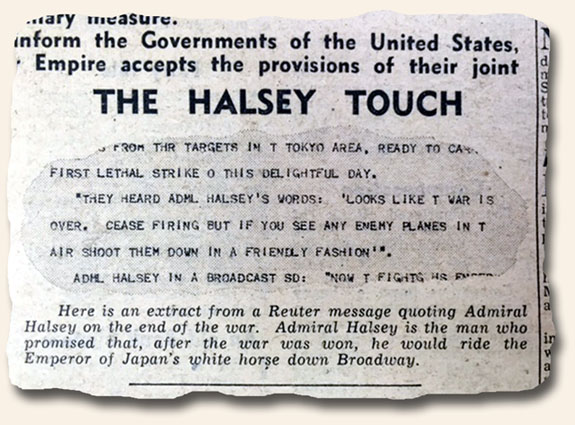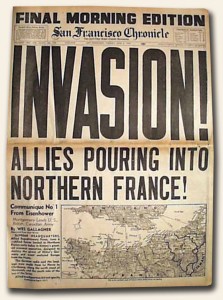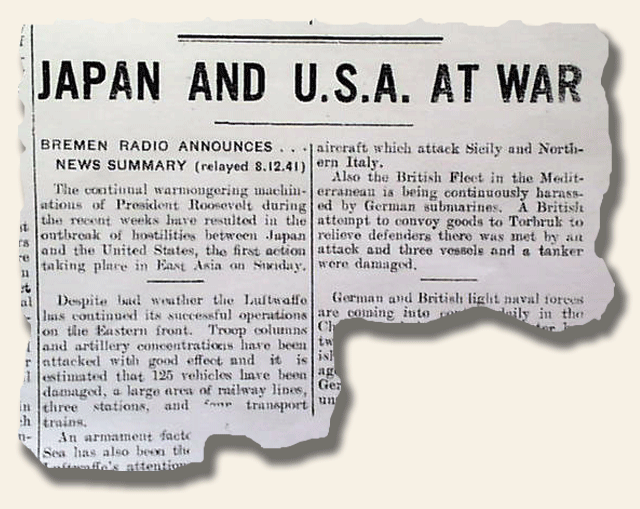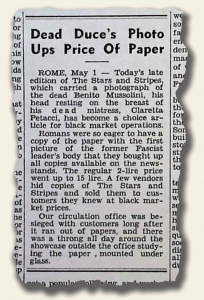Don’t believe everything you read… Hitler rise to power unlikely!
July 14, 2016 by GuyHeilenman · Leave a Comment
One of my favorite quotes regarding the internet, but whose founding warning-principle is rooted in print media is:
“The problem with internet quotes is that you can’t always depend on their accuracy.” -Abraham Lincoln, 1864
 You simply cannot believe everything you read, hear, and in some cases, see. In most instances the misinformation is at least somewhat unintentional. However, sometimes even the well-intended get it wrong – including the so-called experts. Such is the case with a report in the August 16, 1932 edition of the New York Times. The heading in question reads: “Hitler Dictatorship In Reich Held Unlikely“. Just to be sure the heading would not be misinterpreted, a segment of the corresponding text states: “…the probability of Adolph Hitler and the National Socialists gaining power in Germany was not strong…” Let’s just say Frederick J. E. Woodbridge, an esteemed professor of American History at the University of Berlin, was a bit off the mark.
You simply cannot believe everything you read, hear, and in some cases, see. In most instances the misinformation is at least somewhat unintentional. However, sometimes even the well-intended get it wrong – including the so-called experts. Such is the case with a report in the August 16, 1932 edition of the New York Times. The heading in question reads: “Hitler Dictatorship In Reich Held Unlikely“. Just to be sure the heading would not be misinterpreted, a segment of the corresponding text states: “…the probability of Adolph Hitler and the National Socialists gaining power in Germany was not strong…” Let’s just say Frederick J. E. Woodbridge, an esteemed professor of American History at the University of Berlin, was a bit off the mark.
The put it in print… Killing them with kindness?
July 11, 2016 by TimHughes · Leave a Comment
The August 15, 1945 “Evening Standard” newspaper from London, on the day they reported the surrender of Japan to end World War II, included an extract from a Reuter’s message quoting Admiral Halsey on the end of the war: “…Looks like the war is over. Cease firing, but if you see any enemy planes in the air shoot them down in a friendly fashion.”
The Attack on Pearl Harbor… Great Headlines Speak For Themselves…
February 18, 2016 by GuyHeilenman · Leave a Comment
The best headlines need no commentary. Such is the case with the HONOLULU STAR BULLETIN – 1st Extra! printed on December 7, 1941:
The Last Surviving Veterans Who Served at Pearl Harbor…
October 22, 2015 by GuyHeilenman · Leave a Comment
Collecting World War II era newspapers covering significant events continues to be popular among collectors, even though the number of WWII veterans continues to decline. Authentic issues of the Honolulu Star-Bulletin reporting the Pearl Harbor tragedy certainly stand above them all. It is with this in mind we are pleased to post the following article compliments of Francisco Mesa.
The Last Surviving Veterans Who Served at Pearl Harbor
As the years roll by, the list of surviving US veterans of WWII who served at Pearl Harbor when the Japanese Navy attacked the US Navy’s Pacific Fleet inevitably becomes shorter. And with the Pearl Harbor survivors well past their late 80s and some passing even the ripe-old century mark, their numbers are dwindling rapidly all over the US. Last year, just about 2,000 survivors were thought to be around, still.
National Pearl Harbor Remembrance Day
On December 7, 2014, the US President Barrack Obama designated December 7 as the National Pearl Harbor Remembrance Day. Four veterans of the remaining 9 USS Arizona survivors gathered at the Pearl Harbor Visitor Center on December 7, 2014, for a meeting of USS Arizona survivors. The veterans were greeted by music and military salutes from the US Navy Band. Later, they viewed a live feed of an underwater dive beside USS Arizona’s sunken hull that still holds over 900 bodies. For the veterans, each return to Pearl Harbor brings back intense and, sometimes, painful memories.
USS Arizona Reunion Association’s Last Gathering at Hawaii
Although it was the last formal survivor gathering of the erstwhile USS Arizona Reunion Association at Hawaii, the veterans said they still intend to get together—if not in Hawaii, somewhere in the US. Louis Conter, 93, felt he still had some time, and he’d come back to the Pearl Harbor Visitor Center regardless of who else makes it.
Donald Stratton, USS Arizona Survivor
Donald Stratton, 92, of Colorado is another USS Arizona survivor. Don Stratton had been manning the Anti-Aircraft gun batteries. He remained at his battle station on the ship’s port side until the last possible moment. He endured 65 percent burns and a one-year hospitalization. Stratton was medically discharged from the US Navy but re-enlisted a year later. He said that the good Lord saved a precious few from the USS Arizona.
John Anderson, USS Arizona Survivor
John Anderson, 97, was ordered off the USS Arizona, but he wasn’t willing to leave behind his twin brother, Delbert. Although Anderson was forced into a boat and packed off to the safer Ford Island, he returned in an empty boat and rescued three shipmates. Sadly, he didn’t find his brother. Anderson recalled that he had just attended church services that day and had been heading to breakfast when someone warned that the Japanese planes were coming.
Anderson Recalls the Harrowing Experience
Anderson remembers lying in a bomb-blast crater on Ford Island after the surprise attack. He had picked up a rifle and two bandoliers of ammunition and started firing at Japanese aircraft. Anderson had hunkered there through that night with another sailor. In the morning, a passing Marine patrol informed him that survivors of the USS Arizona had to gather at the dock nearby to facilitate a head count. Anderson remembers everyone he saw having rags around their heads. He clearly recalls bandages covered their arms and their skin had been scorched, and their hair had been burned off.
Lauren Bruner, USS Arizona Survivor
Lauren Bruner, 94, had been alongside Don Stratton manning his battle station. There were four others as well. Bruner had escaped from the fiery, sinking battleship by shimmying across a rope that dangled 60 feet above Pearl Harbor’s waters. Bruner had been standing just 70 feet from the spot the torpedo bomb had exploded at the USS Arizona’s forward magazine. He suffered almost 75 percent burns. But that didn’t deter him. Bruner and his comrades were intent on fighting back. There was only one thing that hampered them … they just had to survive the next few moments. So, after catching the attention of one sailor aboard the warship moored alongside their own, a rope stretching almost 100 feet was thrown across.
The Sailors’ Great Escape from the Burning USS Arizona
All the 6 men made the painful—all of them had suffered serious burns—hand-over-hand escape. They had dangled 60 feet in the air as huge flames rising from the oily harbor had burned their skin even more. Bruner had been the second last to leave USS Arizona. Alvin Dvorak, the last one to escape over the rope, had been the one that caught the attention of the sailor on the USS Vestal. Unfortunately, Dvorak succumbed after spending 17 days in the hospital. He had suffered 84 percent burns. Lauren Bruner considers Alvin Dvorak to be the true hero of their great escape. Bruner spent the next seven months in the hospital and returned to the Pacific theater.
Conclusion
Although the survivors of Pearl Harbor are in their early or mid 90s, they can recall the Japanese sneak attack vividly. Many of the survivors fondly hope to live long enough to attend the 75th anniversary of the Pearl Harbor strike in Hawaii on December 7, 2016.
If you are ever visit Hawaii, there are several Pearl Harbor tours that range from just a couple hours to a full day. There are still droplets of oil coming out of the sunken battleship USS Arizona. Also, there are hundreds of people still entombed within the sunken battleship. It is said that the droplets of oil represent the crying of the fallen men and women. And when the droplets of oil stop, the crying will stop.
© Francisco Meza
They put it in print… Nazi generals attempt an escape to Japan…
July 27, 2015 by TimHughes · Leave a Comment
World War II created a countless number of stories of heroism, sorrow, courage, and intrigue, many of which will never be known save for just a few.
 The “The Detroit Free Press” of May 17, 1945 reported one such event which would surprise many historians today. Its headline notes: “Seize U-Boat Taking Key Nazis To Japan” with a subhead: “Luftwaffe Chiefs Captured at Sea“. This was just 10 days after the surrender of Germany, and less than 3 months before Japan would surrender to end World War II. The related article mentions in part: “A 1,600 ton Nazi U-boat, presumably attempting to escape to Japan, surrendered to destroyer-escorts of the U.S. Atlantic Fleet…Aboard were 3 major general of the Luftwaffe and two dead Japanese, who had committed hara-kiri…”.
The “The Detroit Free Press” of May 17, 1945 reported one such event which would surprise many historians today. Its headline notes: “Seize U-Boat Taking Key Nazis To Japan” with a subhead: “Luftwaffe Chiefs Captured at Sea“. This was just 10 days after the surrender of Germany, and less than 3 months before Japan would surrender to end World War II. The related article mentions in part: “A 1,600 ton Nazi U-boat, presumably attempting to escape to Japan, surrendered to destroyer-escorts of the U.S. Atlantic Fleet…Aboard were 3 major general of the Luftwaffe and two dead Japanese, who had committed hara-kiri…”.
To this day few know of the attempt of Nazi generals to seek refuge in Japan, yet it was a front page headline in Detroit at the time.
Ironically, the photo shown is actually of the capture/surrender of the infamous U-505, an event which had occurred in June of 1944, but was not announced/released until the previous day.
A movie in the making?
The Battle of Los Angeles…
March 14, 2014 by TimHughes · 2 Comments
 The “Los Angeles Times–Extra” of February 24, 1942 has one of the more dramatic, screaming headlines to be found in any newspaper: “L.A. AREA RAIDED ! ” with a smaller head noting: “Jap Planes Peril Santa Monica, Seal Beach, El Segundo, Redondo, Long Beach, Hermosa, Signal Hill”. The report begins: “Roaring out of a brilliant moonlit western sky, foreign aircraft flying both in large formation and single, few over Southern California early today and drew heavy barrages of anti-aircraft fire–the first ever to sound over United States continental soil against an enemy invader…” (see).
The “Los Angeles Times–Extra” of February 24, 1942 has one of the more dramatic, screaming headlines to be found in any newspaper: “L.A. AREA RAIDED ! ” with a smaller head noting: “Jap Planes Peril Santa Monica, Seal Beach, El Segundo, Redondo, Long Beach, Hermosa, Signal Hill”. The report begins: “Roaring out of a brilliant moonlit western sky, foreign aircraft flying both in large formation and single, few over Southern California early today and drew heavy barrages of anti-aircraft fire–the first ever to sound over United States continental soil against an enemy invader…” (see).
The Battle of Los Angeles, also known as The Great Los Angeles Air Raid, is the name given to this rumored enemy attack and subsequent anti-aircraft artillery barrage which took place from late February 24 to early February 25, 1942 over Los Angeles. The incident occurred less than three months after the United States entered World War II as a result of the Japanese Imperial Navy’s attack on Pearl Harbor.
Initially, the target of the aerial barrage was thought to be an attacking force from Japan, but speaking at a press conference shortly afterward, Secretary of the Navy Frank Knox called the incident a “false alarm.” Newspapers of the time published a number of reports and speculations of a cover-up. Some modern-day UFOlogists have suggested the targets were extraterrestrial spacecraft. When documenting the incident in 1983, the U.S. Office of Air Force History attributed the event to a case of “war nerves” likely triggered by a lost weather balloon and exacerbated by stray flares and shell bursts from adjoining batteries.
Air raid sirens sounded throughout Los Angeles County on the night of February 24-25, 1942. A total blackout was ordered and thousands of air raid wardens were summoned to their positions. At 3:16 am the 37th Coast Artillery Brigade began firing .50 caliber machine guns and 12.8-pound anti-aircraft shells into the air at reported aircraft; over 1,400 shells would eventually be fired. Pilots of the 4th Interceptor Command were alerted but their aircraft remained grounded. The artillery fire continued sporadically until 4:14 am. The “all clear” was sounded and the blackout order lifted at 7:21 am.
Several buildings and vehicles damaged by shell fragments, and five civilians died as an indirect result of the anti-aircraft fire, three of them killed in car accidents in the ensuing chaos and two of heart attacks attributed to the stress of the hour-long action. The incident was front-page news along the U.S. Pacific coast, and earned some mass media coverage throughout the nation.(credit to Wikipedia)
Headlines drive interest in World War II…
March 11, 2013 by TimHughes · 2 Comments
For likely a multitude of reasons, interest in World War II newspapers ranks far higher than in the Korean War, World War I, or the Spanish-American War. It may be a generational thing, as most collectors today are children of World War II veterans and likely heard stories of the war first-hand, or found  newspapers in their parents attics which sparked an interest. One could debate a number of other possible reasons why other wars lack the intrigue found in that fought by the “greatest generation”.
newspapers in their parents attics which sparked an interest. One could debate a number of other possible reasons why other wars lack the intrigue found in that fought by the “greatest generation”.
Headline collecting has always been a focus for this hobby, and as any collector knows, bold, banner headlines did not become commonplace until late in the 19th century. With the increasing competitiveness of daily newspapers across the country–Hearst, Pulitzer & others rising to prominence–flashier front pages were needed to draw attention at the corner news stand. It’s a shame there is not more interest in the Spanish-American War and World War I as both events resulted in some huge, dramatic, & very displayable headlines.
Because there are a plethora of newspapers from the WWII era available, collectors have become very discriminating in what they collect. Only the “best of the best” will do, meaning just the major events and only those with huge and displayable headlines. If there is a “top 6” list of sought-after events, our experience is they would be: 1) attack on Pearl Harbor; 2) the D-Day invasion; 3) death of Hitler; 4) end of the war in Europe; 5) dropping of the atomic bomb; 6) end of the war in the Pacific. One could add any number of other battle reports such as Midway, battle of the Bulge, fall of Italy, Iwo Jima, battle for Berlin, and so much more. And we could step back before American involvement in the war and add Hitler’s invasion of Poland and the battle of Britain.
The bigger the headline the better. With some newspapers the entire front page was taken up with a headline and a related graphic. The U.S. flag was a common patriotic device. Tabloid-size newspapers commonly had the front page entirely taken up with a singular headline and tend to be better for display given their smaller size.
 And not just American newspapers draw interest. German newspapers hold a special intrigue, but the language barrier is a problem for many. But the British Channel Islands, located in the English Channel between England & France, were occupied by the Nazi during the war so their reports were very pro-Nazi while printed in the English language (ex., Guernsey Island). And the military newspaper “Stars and Stripes“, while certainly being American, was published at various locations in Europe and the Pacific. Collectors have a special interest in finding World War II events in the official newspapers of the American military forces. Plus there were a multitude of “camp” newspapers, amateur-looking newspapers printed on a mimeograph machine for consumption limited to a military base, and typically printed is very small quantities. Their rarity is not truly appreciated by many.
And not just American newspapers draw interest. German newspapers hold a special intrigue, but the language barrier is a problem for many. But the British Channel Islands, located in the English Channel between England & France, were occupied by the Nazi during the war so their reports were very pro-Nazi while printed in the English language (ex., Guernsey Island). And the military newspaper “Stars and Stripes“, while certainly being American, was published at various locations in Europe and the Pacific. Collectors have a special interest in finding World War II events in the official newspapers of the American military forces. Plus there were a multitude of “camp” newspapers, amateur-looking newspapers printed on a mimeograph machine for consumption limited to a military base, and typically printed is very small quantities. Their rarity is not truly appreciated by many.
For obvious reasons, there is also a high degree of collectible interest from those wishing to make sure certain aspects of history are not forgotten. The Holocaust, and the Nazi propaganda used to provide a rationale for eliminating the Jewish people, is well documented in newspapers from the era. In addition to the Holocaust and its atrocities, issues providing context through reporting other pre-war events such as the Great Depression, fascism, and increased militarism, are also desirable.
True to any collectable field, newspaper collectors are always on the lookout for an issue better than what they have, and collection upgrades are constant. Finding that special, rare, unusual or fascinating headline is what makes the hobby fun. Will interest in the Korean War and the Vietnam War gain more interest in future years? Perhaps so. With interest currently low and availability and prices very attractive, it might be a good time to explore.
Roosevelt to blame for the Pearl Harbor attack…
October 16, 2010 by TimHughes · Leave a Comment
We often list on our website issues from the island of Guernsey during World War II when it was occupied by the Nazis. As such all news is filtered through the German propaganda machine which offers interesting reading, as the reports are in English because the residents speak English.
Although many battles reports border on the absurd, particularly with historical hindsight, the front page report in the “Evening Press” dated December 8, 1941, one day after the Pearl Harbor attack, is one of the more outrageous (see the photo below).
The value of a newspaper… impacted by content…
April 12, 2010 by GuyHeilenman · 7 Comments
 One of the common questions received at Timothy Hughes Rare & Early Newspapers is “What elements are involved in determining the collectible value of a newspaper?” Several posts on this subject may be viewed at: “Determining the Value of an Historic Newspaper“. Two of the elements which drive the collectible value of a paper are content and age. For example, the $0.50-$1.00 newsstand price of a Washington Post, USA Today, or Chicago Tribune with the 1st report on the election of President Obama quickly rose to $35 a month (and higher) after the event (content), and will likely be valued at many times this amount in 20+ years (age).
One of the common questions received at Timothy Hughes Rare & Early Newspapers is “What elements are involved in determining the collectible value of a newspaper?” Several posts on this subject may be viewed at: “Determining the Value of an Historic Newspaper“. Two of the elements which drive the collectible value of a paper are content and age. For example, the $0.50-$1.00 newsstand price of a Washington Post, USA Today, or Chicago Tribune with the 1st report on the election of President Obama quickly rose to $35 a month (and higher) after the event (content), and will likely be valued at many times this amount in 20+ years (age).
In contrast, we recently came across a newspaper whose value increased by more than 700% (due to content – a photo) before the end of the day of its initial printing. Our find… the May 1, 1945 Mediterranean edition of Stars and Stripes. The front cover printed the famous photo of Benito Mussolini shown after his execution. In an effort to show a little discretion, the photo is not shown within this post, but may be viewed at: http://www.rarenewspapers.com/view/568477?acl=779383924
Although there have been times when the collectible value of a newspaper increased by the following day, we’d love to know of other pre-2000 events which resulted in an increase in the value of the newspaper on the same day the issue hit the newsstands. If you know of any, feel free to share with the collectible community.
From the military presses during World War II…
January 11, 2010 by TimHughes · Leave a Comment
 Many military units during World War II produced their own little “in-house” newspaper, typically crudely done on a typewriter and reproduced on a mimeograph machine. The reports typically had a more local theme on events happening in camp than reports on the national or international events of the day.
Many military units during World War II produced their own little “in-house” newspaper, typically crudely done on a typewriter and reproduced on a mimeograph machine. The reports typically had a more local theme on events happening in camp than reports on the national or international events of the day.
The large number of such newspapers from just World War II–they existed in the Civil War, Spanish-American War and World War I as well–would allow a hobby onto itself. Their quaintness is often interesting to today’s hobbyists, and their titles and mastheads were often clever. Some of the titles I’ve seen include:
“Medico” “The Stalker” “G.I. Galley” “Dog Tags” “Bulletin Diarrhea” “Airflow” “Mosquito” “Buckaroo” “Prop Wash” “Guinea Gold” “The Saddle Blanket” “The SSHHH” “Garble” “The Bulldog” “Come What Will” “Army Talk” Spacific News” “Poop From Group” “Life O’Reilly” “Goat’s Whisker” “News Jabs” and on and on. It seems like each year a new title crosses my desk.
The photo shows a typical camp newspaper from World War II, this one produced by the “Fourth General Hospital” in New Guinea. Given their focus, their title is both clever and somewhat morbid.



